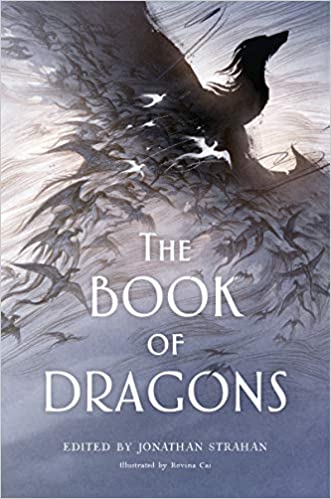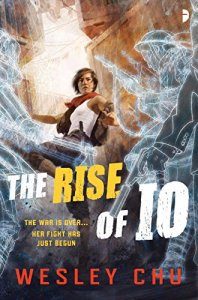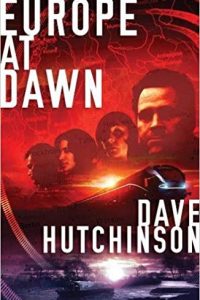Gary K. Wolfe Reviews The Book of Dragons, Edited by Jonathan Strahan
 The Book of Dragons, Jonathan Strahan, ed. (Harper Voyager 978-0-06-287716-1, $35.00, 576pp, hc) July 2020. Cover by Rovina Cai.
The Book of Dragons, Jonathan Strahan, ed. (Harper Voyager 978-0-06-287716-1, $35.00, 576pp, hc) July 2020. Cover by Rovina Cai.
I have to confess that I never quite shared the childhood love of dragons that Jonathan Strahan describes in his introduction to The Book of Dragons. It always seemed to me that dragons were too cool to be really scary, and yet too scary to be adorable, no matter what the Disney people told us. But the 22 stories and seven poems Strahan has assembled in this stellar anthology make a convincing case that they can be all of the above and more. That is, I suppose, just a way of saying that no matter how much panel-discussion blathering we might share about how dragons serve different roles in different cultures or what they might represent in terms of deeply buried psychic traumas or current anxieties, they are above all very useful story elements, and they seem to invoke in many readers a kind of irreducible childhood sense of wonder. That may be one reason so many of the stories here feature youthful protagonists: a boy is raised by dragons on an alien planet in Ann Leckie & Rachel Swirsky’s ”We Continue”; a girl with an abusive father forms a bond over years with a dragon living in the barn in Sarah Gailey’s ”We Don’t Talk about the Dragon”; a nine-year-old visiting her aunt finds a tiny dragon in San Francisco’s Chinatown in Ellen Klages’s ”Pox” (which happily reintroduces us to a key character from her award-winning Passing Strange); and a ten-year-old accidentally creates another tiny dragon in her school science experiment in Kelly Barnhill’s ”Lucky’s Dragon”. The dragon in Seanan McGuire’s delightful ”Hoard” chooses to spend her time in human form as an unconventional foster mother for a series of troubled kids.
For the most part, these dragons are sources more of comfort or protection than of danger, and they suggest something else about the appeal of dragons: they can be emblems of the imagination itself, and of the liberation it offers. In Todd McCaffrey’s ”Small Bird’s Plea”, for example, a young girl on a quest to save her village from demons joins forces with an energy being to transform into a dragon that frees them both from their earlier lives. Conversely to these tales of youth, an aging widow in Kate Elliott’s ”The Long Walk”, left without rights or property after her husband’s death, discovers a kind of liberation she hadn’t suspected after undertaking the long walk of the title, ostensibly designed to provide sacrifices for the local dragons – who, like many of their brethren in these stories, are not quite what they’re expected to be.
The stories by Leckie & Swirsky, Barnhill, and McCaffrey illustrate another important aspect of dragon tales – namely, that they can work equally well as SF or fantasy. The Barnhill story, which may take the anthology’s prize for sheer compelling strangeness, only begins with the tiny science-project dragon, opening up into another world of mysteries involving not only the girl’s oddly unhinged science teacher, but her strange next-door neighbor, an ancient lady whose home seems to be a kind of headquarters for alien researchers. Both the McCaffrey and Leckie/Swirsky stories take place on planets long ago settled by human explorers, while Aliette de Bodard’s harrowing but luminous ”The Last Hunt” is set on an Earth long devastated by invading ”masters” with their ”genmodding” experiments. The title character in JY Yang’s ”The Exile” is a penitent priest assigned to accompany a dragon god on its decade-long mission to terraform a hostile planet for settlement. In what is surely the most inventive use of the idea of dragons, Ken Liu’s ”A Whisper of Blue”, cast in the form of a documentary film, is set in a world in which dragons have so long been used as an energy source – going back all the way to Titusville in 1859, where Edwin Drake discovered dragons rather than oil – and in which their source of combustion derives from a somewhat far-fetched literalization of Maxwell’s Demon.
The Book of Dragons is not without variations on more traditional types of dragon tales. The familiar motif of dragon-slaying is given inventive twists in Michael Swanwick’s ”Dragon Slayer”, with its clever gender-switching and an even more clever use of time travel, while the characteristically sarcastic narrator of K.J. Parker’s ”Habitat” is hired by an arrogant prince to capture a live dragon, a task which he accomplishes with Parker’s equally characteristic pragmatism, leading to a highly satisfactory if mordant ending. When a dragon attacks a school bus in Kelly Robson’s ”La Vitesse”, it falls to the bus driver and her daughter to figure out how to outmaneuver the beast, Fast and Furious-style. The WWII veteran who becomes a dragon-killing sheriff in Scott Lynch’s mini-epic ”Maybe Just Go Up There and Talk to It” – the story takes place over several post-war decades after ”black storms” have brought hordes of dragons into the world – pretty much learns the lesson of the story’s title, though it takes him long enough.
The Parker story is an example of yet another aspect of dragon stories well-represented here – their comic potential. Garth Nix offers one of his delightful Sir Hereward and Fitz stories, involving the rather dim knight bickering with his ensorcelled-puppet partner while trying to use what amounts to demographic research to track down a dragon in hiding. Tiny dragons with a taste for Chinese take-out just show up one day on a woman’s back porch in Theodora Goss’s narrative poem ”The Dragons”, but eventually grow from a nuisance into an opportunity. In Zen Cho’s ”Hikayat Sri Bujang, or, the Tale of the Naga Sage” an arrogant Malaysian dragon, boastful of his ratings on TripAdvisor, finds himself slapped with an environmental-hazard lawsuit because of the storms and floods caused by his antics. The story is also one of several examples of non-Western dragons, along with R.F. Kuang’s ”The Nine Curves River” and McCaffrey’s ”Small Bird’s Plea”.
The Zen Cho story, in turn, leads us to yet another variation, in which the dragon might be a protagonist or central point-of-view character, sometimes in settings that might otherwise be grittily realistic. The hulking protagonist of Brooke Bolander’s ”Where the River Turns to Concrete” works as an enforcer for the gangster who found him as a naked amnesiac years earlier, coming to learn more about himself after he rescues a young boy and befriends his mother. The title character in Daniel Abraham’s ”Yuli” is a former mercenary and assassin now living in suburban USA, trying to raise a grandson whose D&D games become ironic reflections of Yuli’s violent secrets. On a more gentle note, Peter S. Beagle’s quietly magical ”Except on Saturdays” first introduces its mythical figure as a disabled woman on a city bus.
It’s not surprising in the post-Harry Potter world that a couple of the stories might feature wizard schools, but neither Elle Katharine White’s ”Matriculation” nor Patricia A. McKillip’s ”Camouflage” really owe anything to that tradition. White’s tale manages in only a few pages to conjure up a colorful world of dragons, gargoyles, house goblins, and a vampire fittingly assigned the role of pawnbroker, but the tale itself is a rather mundane account of a young student trying to scrounge up enough money for books and tuition at her school for ”magitechnicians.” Masterful as always, McKillip describes a student whose final exam in his ancient sorcery class turns out to involve time travel, Hannibal and his elephants, and part-cephalopod dragons whose skills at camouflage become an important military asset. As with White’s and several other tales, it implies an entire world, and that, in turn, implies an important lesson we might take away from this marvelous anthology – namely, that world-building doesn’t always require volumes of exposition, maps, and glossaries. An intriguing world can be conjured in a few pages or even, in the case of the Jane Yolen poems that open and close the book, in a few evocative lines. Capably following in the brilliant tradition of Gardner Dozois’s Book of Magic or Book of Swords, The Book of Dragons seems almost certain to be the most significant fantasy anthology of 2020.
Gary K. Wolfe is Emeritus Professor of Humanities at Roosevelt University and a reviewer for Locus magazine since 1991. His reviews have been collected in Soundings (BSFA Award 2006; Hugo nominee), Bearings (Hugo nominee 2011), and Sightings (2011), and his Evaporating Genres: Essays on Fantastic Literature (Wesleyan) received the Locus Award in 2012. Earlier books include The Known and the Unknown: The Iconography of Science Fiction (Eaton Award, 1981), Harlan Ellison: The Edge of Forever (with Ellen Weil, 2002), and David Lindsay (1982). For the Library of America, he edited American Science Fiction: Nine Classic Novels of the 1950s in 2012, with a similar set for the 1960s forthcoming. He has received the Pilgrim Award from the Science Fiction Research Association, the Distinguished Scholarship Award from the International Association for the Fantastic in the Arts, and a Special World Fantasy Award for criticism. His 24-lecture series How Great Science Fiction Works appeared from The Great Courses in 2016. He has received six Hugo nominations, two for his reviews collections and four for The Coode Street Podcast, which he has co-hosted with Jonathan Strahan for more than 300 episodes. He lives in Chicago.
This review and more like it in the July 2020 issue of Locus.
 While you are here, please take a moment to support Locus with a one-time or recurring donation. We rely on reader donations to keep the magazine and site going, and would like to keep the site paywall free, but WE NEED YOUR FINANCIAL SUPPORT to continue quality coverage of the science fiction and fantasy field.
While you are here, please take a moment to support Locus with a one-time or recurring donation. We rely on reader donations to keep the magazine and site going, and would like to keep the site paywall free, but WE NEED YOUR FINANCIAL SUPPORT to continue quality coverage of the science fiction and fantasy field.






